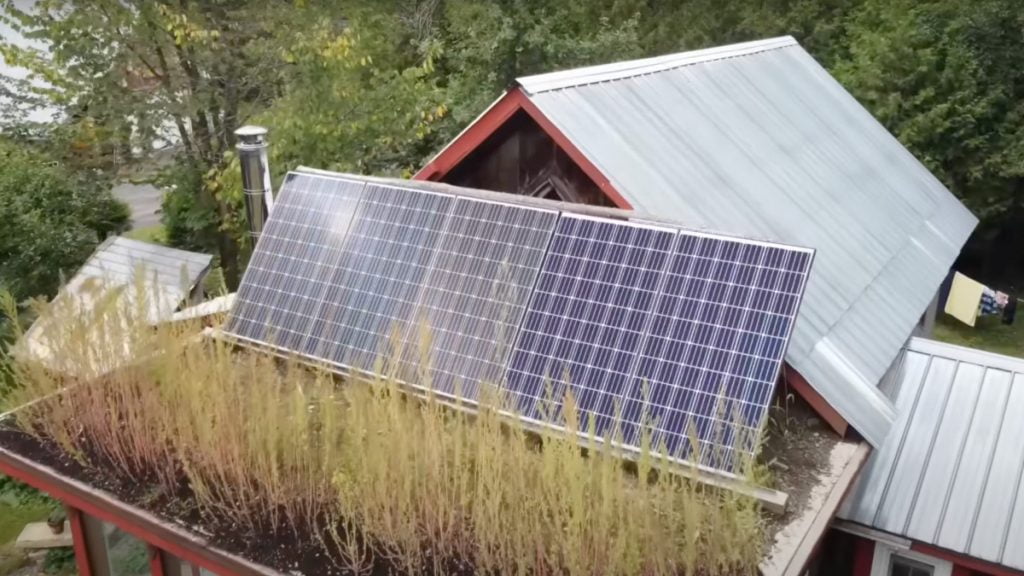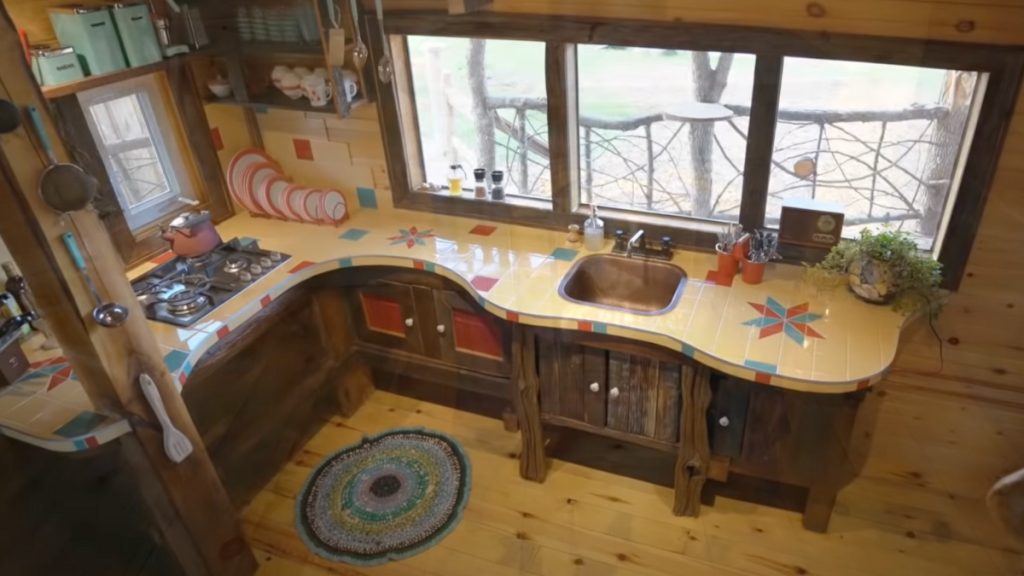Living off-grid used to be seen as something only the most hardcore survivalists and environmentalists would attempt. But over the past decade or so, it’s become an increasingly popular lifestyle choice for people looking to live more sustainably, self-sufficiently, and in connection with nature.
In this post, I’m going to share the inspirational 15-year off-grid journey of Stephanie and Joel, who built their own off-grid cabin from scratch and now grow most of their own food on their land in Canada.
After reading this, you’ll have a good understanding of what living off-grid entails and what it takes to make it work long-term. You won’t believe how they live!
Oh, and if you want to try this type of experience, they even built a cute mushroom-shaped off-grid tiny home that is available on AirBnB. Keep reading to check it out, it’s SUPER cute!
Going Off-Grid from Scratch on a Small Budget

Stephanie and Joel had long dreamed of living off the land and building their own off-grid home. In 2007 they got the opportunity to do just that when some shared land became available. They jumped at the chance even though they had very little money at the time.
They started off building a simple outhouse with an attached workshop. This gave them a place to live while they worked on the main cabin. The first winter was rough with gaps in the walls and freezing temperatures, but they toughed it out while continuing to work on the cabin every chance they got.
In total, they built their initial 400 square foot off-grid cabin for around $5000. This included the cost of tools and salvaged building materials. Here are some of the key details about how they built their cabin on a shoestring budget:
- Used salvaged materials from the dump, an old barn on the property, and whatever they could get for free
- Built the structure mainly from post and beam technique
- No electricity at first other than a few candles
- Toughed out the first winter with gaps between the logs and wearing snowsuits indoors
It took years to slowly finish the cabin to the point where it was fully insulated and livable. But the whole time they enjoyed being off-grid and learning new homesteading skills.
Evolving the Solar Power System Over Time
Of course one of the biggest aspects of off-grid living is generating your own power. Solar is generally the most practical and cost-effective solution for off-grid homes today.
Stephanie and Joel started off with no electricity at all. Within the first couple of years they got one small solar panel and a battery which allowed them to run some lights in the evening.
Over time as their budget allowed, they continued expanding the solar system. Here is how it evolved:
- Started with 1 small panel, 1 deep cycle battery, run a few lights
- Expanded to a few more panels and batteries as they could afford it
- Now have a 5 panel, 400 Ah lithium battery system
- Runs fridge, washing machine, lights, TV, computer, etc.
- Added a generator to supplement on cloudy winter days

So they went from having no electricity and living by candlelight to now having enough power for normal appliances and devices. But it took time, patience, and slowly investing in better equipment.
These days a basic solar panel, battery, and inverter system can be purchased for a relatively low cost if you don’t need to run high electricity demanding appliances.
Heating and Cooling the Off-Grid Cabin
When living off the grid, heating and cooling typically require some unique solutions compared to a conventional grid-tied home. Wood stoves are commonly used for heating, and passive solar design along with open windows provides cooling in summer.
For the first many years, Stephanie and Joel heated their off-grid cabin solely with a small wood stove. While cozy, it was inefficient and required stoking the fire multiple times throughout cold winter nights.
Eventually, they upgraded to a larger, more efficient wood cookstove. This provided heating and a cooking surface. They also added a propane stove with a thermostat, which provides supplemental heat without having to wake up and tend the fire.
In summer they rely on passive solar design and natural breezes for cooling. The cabin stays nice and cool thanks to the overhangs on the windows and the thermal mass of the logs. No need for AC off-grid!
Water Collection for Drinking, Bathing, etc.
When living off-grid you become acutely aware of where your water comes from and how much you use. Conservation and reuse become second nature.
Stephanie and Joel’s drinking water comes from a well on the property. For other uses like bathing and washing dishes they collect rainwater in a large reservoir tank.
The reservoir tank is gravity fed to supply running water in the kitchen and bathroom. No electric pump required!
They do have a small solar-powered pump for fetching water from the nearby quarry to fill the reservoir when it’s not raining.
For hot water they used to heat water on the stove but now have an on-demand propane water heater. And the off-grid cabin has both a full bathroom and a luxurious outdoor shower!
There are also other off-grid water systems that they don’t use, if you are curious, you can check them out here.
Growing Food in the Off-Grid Garden
A huge benefit of living off-grid on acreage is the ability to grow a lot of your own food! This provides healthy organic food and greatly reduces reliance on external food sources.
Stephanie and Joel grow tons of fruits, vegetables, mushrooms, and herbs in their large gardens. Here are some of the things they produce:
- Fruit: grapes, berries, apples, pears
- Veggies: corn, tomatoes, peppers, potatoes, beans, cucumbers
- Herbs and mushrooms
- Honey from bee hives
They also raise chickens, turkeys, and pigs for meat, eggs, and milk. And with Joel’s skills as an arborist they are never short on firewood for heating the home!
Self-sufficiency feels very gratifying. And being able to walk out your door and pick ingredients for a meal is pretty sweet.
Generating Income Off-Grid
Most off-grid homesteads still need to generate at least some income to get property taxes paid and buy what they can’t produce themselves.
For Joel and Stephanie, the main income source is Joel’s tree service business. He puts his skills with chainsaws and rigging to work felling trees in the area.

Stephanie generates income through her unique off-grid Airbnb rental cabin. Visitors come to learn about off-grid living and work in exchange for a free stay. What an awesome idea!
They’ve also produced maple syrup, fruit wines, and grown produce to sell at the farmer’s market. And their daughter has an adorable lemonade stand. There are lots of creative ways to make money off-grid.
Building an Off-Grid Guest Cabin

After living off-grid in their self-built cabin for 15 years, Stephanie and Joel decided to construct a stunning off-grid guest cabin called “The Pickalotta”.
This artistic tiny home allows them to share their off-grid living knowledge with others through Airbnb rentals. It’s been a successful side business venture so far.
Some key details about The Pickalotta off-grid cabin:
- 320 sq ft two-story cabin with green roof
- Constructed from reclaimed and salvaged materials
- Solar powered – 420W panels, 200Ah batteries
- Propane powered appliances
- Gravity-fed rainwater system
- Incinerating toilet
- Outdoor shower
- Access to large garden and food forest
Guests at The Pickalotta get to experience off-grid living in comfort with all the mod cons. It’s a beautiful little cabin packed with artistic details. You can check it out and book here: The Pickalotta on Airbnb
Conclusion
The off-grid journey of Stephanie and Joel shows that you can build a comfortable, sustainable homestead even starting from scratch on a budget. It takes time, patience, resourcefulness, and learning new DIY skills along the way.
Off-grid living connects you with nature, provides food security through gardening, and allows for a high degree of self-sufficiency. It’s incredibly rewarding although not always easy. Stephanie and Joel’s story is inspirational for anyone considering an off-grid adventure.
Would you be living off-grid like this? Let me know in the comments below!


